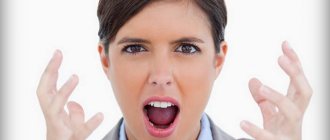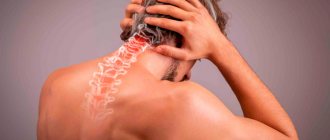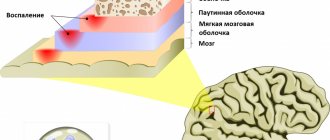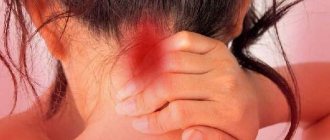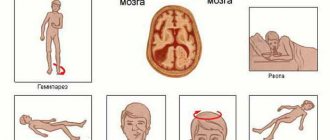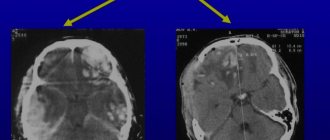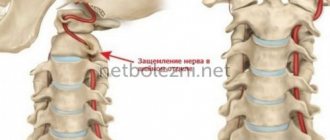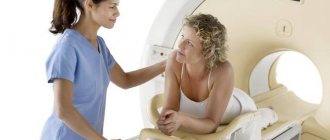Causes of headaches with sudden movements
Pain may occur with sudden bending or turning of the head. This is due to pathologies of blood vessels, nerves, pressure changes and other reasons. Pain can also appear in a healthy person due to intense physical activity, stress and disruption of the sleep schedule. Most often, painful sensations go away after proper rest, but in some patients they indicate serious disorders that require treatment.
Migraine
Migraine is an acute headache that manifests itself without organic pathologies of blood vessels, brain and other organs. Doctors associate it with neurological disorders or vascular weakness. It has also been established that migraine is more often of hereditary origin and occurs simultaneously in several family members. It has a chronic course and manifests itself in the form of attacks, which can be caused by internal or external factors. Thus, migraines often occur against the background of climate change, stress, insomnia, and intense training.
The attack can last up to several days and consists of four phases:
- The prodromal period is a few days before the onset of headache. During this time, many patients experience weakness, dizziness, insomnia, as well as hearing and vision impairment. However, symptoms may be mild and unnoticeable.
- Aura is a neurological disorder that occurs immediately before or during the onset of a headache. An aura can include visual, auditory and movement (motor) disturbances, as well as combinations thereof. Characteristic symptoms are the appearance of dark circles in the field of vision, tinnitus, nausea and dizziness, and deterioration in coordination of movements. About 50% of migraine cases occur with aura; in other patients it is absent. (see Migraine with aura).
- The pain phase lasts no more than a few hours in children and 1–3 days in adults. The pain is sharp, severe, often spreading to the temples and the side of the head. It intensifies with any physical activity and sudden movements of the neck. During this phase, nausea and dizziness, weakness, and impaired consciousness and concentration may also be felt.
- Postdromal period - occurs when the headache goes away. A few days after the attack, you may feel worse. Patients experience weakness, gastrointestinal disorders, mood swings and other symptoms that disappear within 1–2 days, depending on the intensity of the attack.
Migraine often affects only half of the head, but can spread to its entire surface. The headaches are severe and worsen when turning and tilting the head, as well as with any sudden movements of the neck. Mild attacks can be relieved with painkillers, but for acute pain, the doctor will prescribe special medications against migraines.
Read more in the material: Chronic migraine
Hypertension
The blood pressure of a healthy person at rest is 120/80 mm. rt. Art. It is easy to measure at home using a tonometer. If the result is 130/90 mm. rt. Art. and more, we can talk about hypertension (high blood pressure). It is important that hypertension is physiological - blood pressure normally increases after exercise. To obtain accurate data, they were shown filming during rest.
Hypertension is a chronic disease that is manifested by increased blood pressure. It is most often diagnosed in middle and old age, but can also occur in young adults and children. Its causes are congenital disorders of pressure regulation mechanisms and acquired vascular diseases. During an attack, blood pressure increases sharply, which is accompanied by the following symptoms:
- throbbing headache, which intensifies when tilting and turning the head - it can spread to the temples, back of the head, frontal part;
- deterioration of vision, hearing, concentration;
- numbness of fingers and toes;
- swelling, redness of the skin of the face and mucous membranes;
- the appearance of small subcutaneous hematomas, especially in the face;
- arrhythmia, uneven and rapid pulse.
People who are overweight and those who lead a sedentary lifestyle are at risk. To treat hypertension, your doctor will select a special diet and prescribe medications to correct your blood pressure. They must be taken in a course to prevent another exacerbation.
Read more in the material: Headache with hypertension
Diseases of the cervical spine
The cervical region contains important vessels and nerves that lead to the brain. They are located in the protective canal formed by the openings between the vertebrae and on their lateral processes. In a healthy person, between the bone segments there are intervertebral discs - dense, elastic cartilaginous formations that absorb shock during movement. Their damage can be caused by various diseases, but leads to acute pain and affects general well-being.
- Cervical osteochondrosis is a chronic process of destruction of intervertebral discs. It can be caused by intense exercise, a sedentary lifestyle, or a disruption in the flow of blood to the cartilage. It leads to compression of the nerve roots and acute headaches, which intensify with neck movements. (see Headache with osteochondrosis of the cervical spine)
- Protrusion is a protrusion of cartilage beyond the spinal column. The process is accompanied by headaches and decreased neck mobility. In advanced cases, a hernia forms - the outer fibrous membrane ruptures, and the liquid contents (nucleus pulposus) leak out.
- Spinal curvature can be congenital or acquired. The process is often caused by incorrect posture and intense stress during the period of growth and formation of the spinal column.
To treat diseases of the cervical spine, the doctor will prescribe a comprehensive treatment regimen. It may include exercises to strengthen the neck muscles, massage and physiotherapy, as well as a course of medications. Painkillers and anti-inflammatory drugs, muscle relaxants, and warming ointments help with these diseases.
Vascular diseases
Atherosclerosis is one of the reasons why headaches occur during sudden movements. This is a chronic disease in which lipoproteins and cholesterol are deposited on the inner walls of the arteries. These deposits can form plaques, cause narrowing of the lumen of blood vessels and reduce the elasticity of their walls. This leads to a deterioration in blood flow to the brain and painful sensations. At the first signs of atherosclerosis, it is important to follow a low-fat diet, as well as take medications to remove excess cholesterol.
Read more in the material: Constriction of cerebral vessels
Diseases of the ENT organs
Headaches with sudden movements can also be caused by inflammation of the ears, mucous membrane of the nasopharynx or respiratory tract. Colds occur when a viral infection occurs and the body's immune defense is simultaneously reduced. It is important to get tested if the following symptoms worsen:
- fever for 3 days or more;
- the appearance of discharge from the nose or ear canals;
- weakness, headache;
- pain in the head area.
A characteristic symptom of sinusitis is a sharp headache when tilting the head down. If it is confirmed, the doctor will prescribe an additional x-ray examination. Treatment for most diseases of the ENT organs includes antibiotic therapy, lavage of the nasal passages, the use of ear drops and vasoconstrictors.
Other reasons
Headaches often appear due to stress, nervous tension, changes in atmospheric pressure and disturbances in sleep schedule. However, if they occur frequently, including after exercise, it is important to get tested. These symptoms may indicate the following disorders:
- brain tumors;
- neuritis - inflammation of the nerves that run in the neck and head;
- poisoning – associated with the intake of poisons and toxins from food, medicines, gaseous substances;
- stroke is one of the dangerous conditions that occurs when there is a sudden disruption of blood circulation in the brain; (See stroke)
- temporal arteritis is a specific disease in which inflammation of the temporal artery occurs;
- cluster pain is a rare type that is very severe. (see Cluster headaches)
Headaches are not a separate disease, but a symptom characteristic of many disorders. Doctors do not recommend enduring painful sensations. As first aid, you can take a pain reliever, but then it is important to undergo a full examination.
Causes of headaches
The brain is the center - the organ for controlling the body, and if painful sensations visit it regularly, it can malfunction. The main reasons why headaches occur:
- stress;
- overvoltage;
- lack of sleep;
- poor nutrition;
- alcohol, nicotine, drugs;
- excessive use of medications;
- changes in blood pressure;
- sedentary lifestyle;
- chronic diseases.
This is not a complete list of possible causes that cause headaches.
Everyone who suffers from migraine attacks may have their own irritating factors that provoke pain:
- bright light;
- loud noise;
- acrid smell.
Headache attacks can be classified as a group of neurological diseases if they are not caused by serious diseases of other organs. Most often, when we have a headache, we take a painkiller and leave it for a while.
But the attack may recur and with greater force. Eliminating pain does not eliminate the causes of its manifestation. If you experience headache attacks at regular intervals, you should definitely consult a doctor.
In principle, the causes of headaches can only be determined after a complete medical examination. Sometimes it happens that pain occurs at a certain time of day or in a certain position. There are times when an attack occurs if the head is tilted down.
If pain is felt in the back of the head, this may indicate problems in the spine, directly in its cervical region. Such situations arise due to injuries, a sedentary lifestyle, sedentary work, drafts, and the body being in an uncomfortable position for a long time.
It is recommended to consult a neurologist, and, if necessary, consult a traumatologist or cardiologist. Also, disturbances in the functioning of the blood vessels in the brain can cause migraine attacks. If the vessels sharply narrow or dilate, a pressure drop will occur.
Infectious diseases of the brain can affect the functioning of the brain and cause swelling. If you remain in a position with your head tilted for a long time, brain tissue begins to put pressure on the nerve endings.
When you tilt your head down, the headache may occur in one part of the head, move around, or cover the entire head. Based on the nature and location of the pain, one can assume the cause of its occurrence.
When tension in the forehead muscles and pressing sensations on the eyes occur in the evening, and such attacks appear quite often, it can be assumed that the reason for this is stressful situations that occur during the day or overexertion.
It is advisable to consult a doctor. As a preventative measure, you can drink herbal tea and sleep for eight to ten hours. For complete restoration of the body.
If, when tilting the head, a headache occurs, which is accompanied by nausea, irritation from bright light, and general weakness. This may indicate dilation of the blood vessels in the brain, resulting in increased activity of its functions.
One of the reasons for a headache when tilting the head down is considered to be sinusitis. The pain begins to be felt in the form of pulsation in the forehead, temples and face. They usually start in the morning, after waking up.
They are often confused with migraine attacks. Because the symptoms are very similar. Signs of headache with sinusitis:
- pressing sensations in a certain part of the head;
- discomfort when touching the face;
- increased pain when bending forward and down;
- in the morning the pain is felt more strongly;
- sudden change in ambient temperature;
- concomitant colds.
Diagnostic methods
At home, it is impossible to determine exactly why a headache occurs. This information is necessary to choose an effective treatment that will affect not only the symptoms, but also their cause. The doctor will prescribe a set of examinations, which may include:
- X-ray of the cervical spine is the easiest way to diagnose osteochondrosis and other neck diseases;
- Dopplerography - ultrasound of the vessels of the neck and head using a contrast agent;
- MRI, CT – examinations that will allow you to accurately visualize intervertebral protrusions and hernias, neoplasms and hematomas of the brain, the consequences of a stroke;
- Blood tests will show inflammatory processes and metabolic disorders.
The Clinical Brain Institute offers individual headache diagnostic programs. The main advantages of our center are precise modern equipment and comfortable conditions for a hospital stay during the period of examination and treatment. Learn more about our programs.
What can trigger a headache when bending down?
- asthma, seasonal complications;
- allergy;
- any formations in the nasal cavity, polyps, tumors;
- increase in atmospheric pressure, rise to high altitude;
- diving.
In order to establish the correct diagnosis, it is necessary to visit a doctor. After the medical examination, the doctor will conduct a survey to find out your feelings during the illness. If necessary, it is possible to consult with an ENT doctor.
He will be able to give an opinion about possible sinusitis or diseases that have similar symptoms. It is necessary to determine: the presence of discharge from the nasal cavity, whether there is a cold, the presence of allergies, pain on the face, in the nasolabial triangle, and conduct an examination of the sinuses.
A disease such as sinusitis can have a chronic form. For a complete examination, it is necessary to conduct a computed tomography, magnetic resonance imaging.
If you have these symptoms:
- acute headache that does not stop during the day;
- attacks of headache with increasing pain;
- constant headaches after fifty years of age;
- headaches during which vision deteriorates, general weakness, confusion, and impaired coordination of movements occur;
- increased body temperature, nausea, gag reflex;
- redness of the eyeballs.
It is necessary to urgently consult a doctor, call an ambulance!
To cure headaches when tilting your head down, you need to eliminate the root cause of their origin.
If it is sinusitis, undergo treatment from an otolaryngologist. Usually, during an exacerbation, antibiotics are prescribed to relieve the inflammatory process. After which it is necessary to follow certain preventive measures:
- use humidifiers;
- use a saline solution to clean the sinuses;
- periodically do inhalations;
- undergo head, neck and back massage sessions.
These methods will help you avoid blockage of your sinuses and, as a result, avoid headaches when tilting your head down. Pharmacies sell a large number of nasal sprays and inhalers; choose the one most suitable for your body.
Inhalations can be performed at home using medicinal plants; such procedures will be beneficial for the whole body. Be sure to find out if you are allergic to medicinal herbs and medications.
Treatment of headaches
The treatment regimen will include steps to relieve symptoms and eliminate the causes of the headache. It is prescribed only after an examination, when it becomes known why pain and discomfort occur with sudden movements. It may include the following methods:
- drug treatment - includes taking antibiotics, muscle relaxants, painkillers and anti-inflammatory drugs;
- therapeutic exercises – at home it is useful to perform exercises to strengthen and relax the neck muscles;
- physiotherapy - targeted effects of a magnetic field, electric current, heat on painful areas;
- massage - the procedure must be performed by a specialist.
Doctors at the Clinical Brain Institute warn that self-medication can lead to dangerous consequences and the gradual development of chronic diseases. The effectiveness of the prescribed regimen depends not only on taking medications, but also on the implementation of other prescriptions: a therapeutic diet, exercises at home and other procedures.
Why can sinusitis cause headaches?
The nose is the organ through which oxygen enters the body. All microorganisms in the environment can get in with it.
After which an infectious disease occurs, most often of a cold nature.
With such diseases, inflammation of the nasal sinuses usually occurs. Purulent formations are released. That is, this part of your body is in an inflamed state and when you bend down, there is a sharp rush of blood, which leads to a headache.
It is often very easy to confuse a migraine attack and sinusitis; the symptoms are similar. If you have a migraine attack, the headache may be in the frontal or temporal part; when bending down, the pain intensifies, and a feeling of a stuffy nose appears.
Doctors conducted an experiment. About a hundred people were interviewed who thought they had sinusitis. And during the examination it turned out that almost ninety percent of those participating in the experiment suffered from migraine pain.
During migraine attacks, the pain intensifies when triggers appear - bright light, noise, smell. All this happens due to very similar symptoms.
Correct diagnosis brings a positive effect, but an incorrect diagnosis can harm health and prolong the suffering of the patient. Therefore, do not self-medicate under any circumstances.
Headache with sinusitis occurs due to inflammation of the nasal sinuses and their overload. Sinusitis can occur as a result of a cold or infectious disease. Allergies can also cause it.
At such moments, the body’s immune system is weakened, so viruses actively multiply. During the course of sinusitis, breathing through the nose becomes difficult. This can happen due to the accumulation of mucus in the nose or throat. After this, pus forms in the nasal sinuses, which does not come out of the nose. Remaining inside the body, it penetrates through the tissues into the blood.
This is why headaches appear when you tilt your head down. The process of blockage of the nasal sinuses with the subsequent formation of bacteria in them causes headaches.
Prevention methods
Headaches are rarely a consequence of congenital pathologies; more often they arise as a result of acquired diseases. They can be prevented if you follow simple recommendations from doctors:
- monitor your posture throughout the day and while working at the monitor;
- do gymnastics for your back and neck every day;
- choose proper nutrition, give up fatty foods and fast food;
- get rid of bad habits.
Headaches are a dangerous symptom that may indicate dangerous diseases. At the Clinical Brain Institute, you can undergo a comprehensive diagnosis and determine what is causing it. Experienced doctors will select an individual treatment regimen to not only get rid of pain, but also stop the further development of diseases.
Clinical Brain Institute Rating: 3/5 — 2 votes
Share article on social networks
